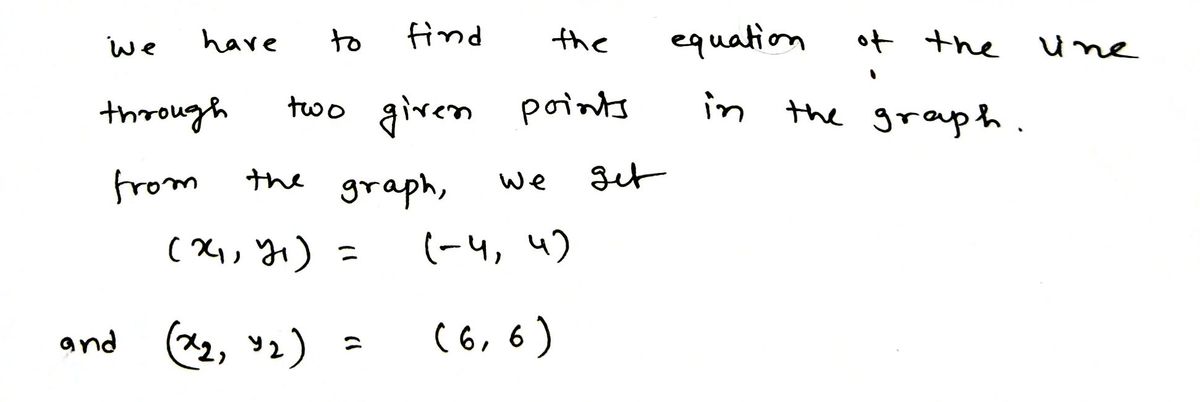Calculus: Early Transcendentals
8th Edition
ISBN:9781285741550
Author:James Stewart
Publisher:James Stewart
Chapter1: Functions And Models
Section: Chapter Questions
Problem 1RCC: (a) What is a function? What are its domain and range? (b) What is the graph of a function? (c) How...
Related questions
Question
Find the equation of the line
![**Title: Determining the Equation of a Line Through Two Given Points**
**Introduction:**
This lesson focuses on understanding how to determine the equation of a line using two given points on a graph. This is a fundamental concept in algebra and coordinate geometry, often used to describe linear relationships.
**Graph Explanation:**
The graph features a Cartesian coordinate system with labeled axes: the horizontal axis (x-axis) and the vertical axis (y-axis). The graph is enclosed by a square boundary, providing a structured area for plotting.
On the graph, a straight line is depicted, passing through two specific points, which are highlighted with small circles. The line extends from the lower left to the upper right, indicating a positive slope.
**Coordinates of Points:**
- The first point is located at approximately (-4, 3).
- The second point is located at approximately (6, 6).
**Line Characteristics:**
- **Slope Calculation:** The slope (m) of the line can be calculated using the formula:
\[
m = \frac{y_2 - y_1}{x_2 - x_1}
\]
Substituting the point coordinates:
\[
m = \frac{6 - 3}{6 - (-4)} = \frac{3}{10}
\]
- **Equation of the Line:** Using the point-slope form, \(y - y_1 = m(x - x_1)\), we can write the equation of the line:
Using the first point (-4, 3) and the slope \(m = \frac{3}{10}\):
\[
y - 3 = \frac{3}{10}(x + 4)
\]
Simplifying, the equation in slope-intercept form is:
\[
y = \frac{3}{10}x + \frac{27}{10}
\]
**Conclusion:**
Understanding how to determine the equation of a line from two points allows students to model real-world scenarios that exhibit linear behavior. Practice with similar exercises will strengthen familiarity with coordinate systems and linear relationships.](/v2/_next/image?url=https%3A%2F%2Fcontent.bartleby.com%2Fqna-images%2Fquestion%2F379782e3-36e2-4b06-9a33-e2601af30423%2F5677ac9a-778c-4ae7-b6cb-eebb81065fde%2Fmet4jy_processed.jpeg&w=3840&q=75)
Transcribed Image Text:**Title: Determining the Equation of a Line Through Two Given Points**
**Introduction:**
This lesson focuses on understanding how to determine the equation of a line using two given points on a graph. This is a fundamental concept in algebra and coordinate geometry, often used to describe linear relationships.
**Graph Explanation:**
The graph features a Cartesian coordinate system with labeled axes: the horizontal axis (x-axis) and the vertical axis (y-axis). The graph is enclosed by a square boundary, providing a structured area for plotting.
On the graph, a straight line is depicted, passing through two specific points, which are highlighted with small circles. The line extends from the lower left to the upper right, indicating a positive slope.
**Coordinates of Points:**
- The first point is located at approximately (-4, 3).
- The second point is located at approximately (6, 6).
**Line Characteristics:**
- **Slope Calculation:** The slope (m) of the line can be calculated using the formula:
\[
m = \frac{y_2 - y_1}{x_2 - x_1}
\]
Substituting the point coordinates:
\[
m = \frac{6 - 3}{6 - (-4)} = \frac{3}{10}
\]
- **Equation of the Line:** Using the point-slope form, \(y - y_1 = m(x - x_1)\), we can write the equation of the line:
Using the first point (-4, 3) and the slope \(m = \frac{3}{10}\):
\[
y - 3 = \frac{3}{10}(x + 4)
\]
Simplifying, the equation in slope-intercept form is:
\[
y = \frac{3}{10}x + \frac{27}{10}
\]
**Conclusion:**
Understanding how to determine the equation of a line from two points allows students to model real-world scenarios that exhibit linear behavior. Practice with similar exercises will strengthen familiarity with coordinate systems and linear relationships.
Expert Solution
Step 1

Step by step
Solved in 2 steps with 2 images

Recommended textbooks for you

Calculus: Early Transcendentals
Calculus
ISBN:
9781285741550
Author:
James Stewart
Publisher:
Cengage Learning

Thomas' Calculus (14th Edition)
Calculus
ISBN:
9780134438986
Author:
Joel R. Hass, Christopher E. Heil, Maurice D. Weir
Publisher:
PEARSON

Calculus: Early Transcendentals (3rd Edition)
Calculus
ISBN:
9780134763644
Author:
William L. Briggs, Lyle Cochran, Bernard Gillett, Eric Schulz
Publisher:
PEARSON

Calculus: Early Transcendentals
Calculus
ISBN:
9781285741550
Author:
James Stewart
Publisher:
Cengage Learning

Thomas' Calculus (14th Edition)
Calculus
ISBN:
9780134438986
Author:
Joel R. Hass, Christopher E. Heil, Maurice D. Weir
Publisher:
PEARSON

Calculus: Early Transcendentals (3rd Edition)
Calculus
ISBN:
9780134763644
Author:
William L. Briggs, Lyle Cochran, Bernard Gillett, Eric Schulz
Publisher:
PEARSON

Calculus: Early Transcendentals
Calculus
ISBN:
9781319050740
Author:
Jon Rogawski, Colin Adams, Robert Franzosa
Publisher:
W. H. Freeman


Calculus: Early Transcendental Functions
Calculus
ISBN:
9781337552516
Author:
Ron Larson, Bruce H. Edwards
Publisher:
Cengage Learning